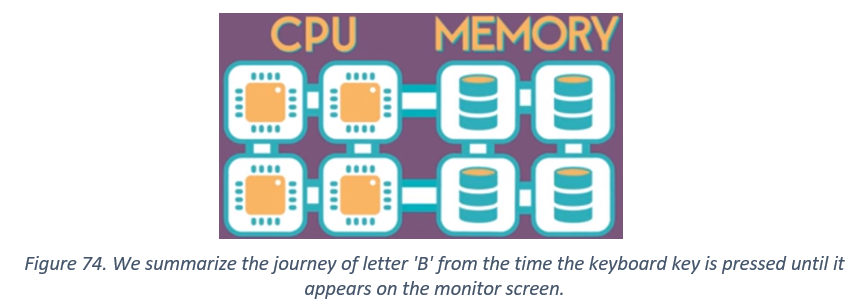If we want to know how computers work, everything comes down to the binary number system, these simple ones and zeros, and the electrical signals of the schemes that make them. They are the backbone of how all computers input, store process and output information.
Recall that under the surface all computers are doing the same four main actions. They receive information, store it, process it and eventually output information. Each of these actions is carried out by a different part of the computer. There are input devices that they accept input data from the outside world and convert them into binary information. There is memory in which this information is stored. There is a central processor, or CPU, where all calculations are performed. Finally, there are output devices, which take the information and convert it into physical output. Computers accept many kinds of input data - from the computer keyboard, from the touchscreen of the phone, camera, microphone, GPS…. Even car sensors, thermostats and drones are types of input devices.
Let us see a simple example of how input data travels through a computer and becomes output. When you press a key on the keyboard, for example "B", the keyboard converts the letter into a number in binary. Starting from this number, the computer calculates how to show the letter "B" pixel by pixel. The CPU requests memory instruction about how to step by step paint the letter "B". The CPU executes these instructions and stores the value for each pixel inside the memory. Finally, this pixel information is sent in binary form to the screen that is the output device. It converts binary signals into small lights and colors, which make up what we see.

It all happens so fast, that it feels like it is instantaneous, but to show each letter, the computer runs thousands of instructions that start when a key is pressed. In this example, the output device was a screen, but there are many different types of output, which receive binary signals from the computer and output something in the physical world.

For example, speakers produce sound, the three-dimensional printer will print an object. Output devices can control physical movements, such as a robotic hand or a car engine. New types of input and output devices allow computers to interact with the world in entirely new ways. This is thanks to the speed improvements and the size of the memory and CPU. The more complicated a task is and the more information there is at input and output, the more computational power and memory needed by the computer. Printing letters on the screen may be easy, but for the creation of realistic 3D graphics or for capturing a high-resolution movie, modern computers often use multiple processors to process all this information and have lots of memory in which to store data.